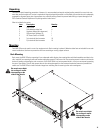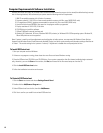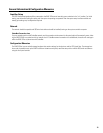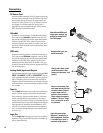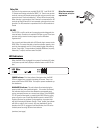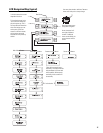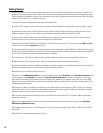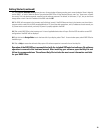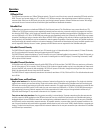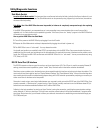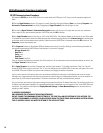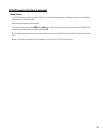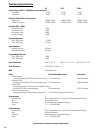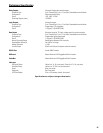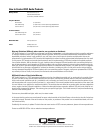
20
Operation
QSControl Port
The QSControl port operates on a 10BaseT Ethernet network. This port is one of the primary means for connecting QSControl.net to the
RAVE. The port may connect directly to a PC's 10BaseT or 10/100 (auto-sensing or auto-negotiating) network interface card using a
crossover cable. Data from the QSControl port may also pass through network repeaters, network switches and routers. We strongly
recommend the use of network switches to facilitate higher bandwidth and dedicated connections.
CobraNet Port
The CobraNet port operates on a dedicated 100BaseTx (Fast Ethernet) network. The CobraNet port may connect directly to a PC's
100BaseTx or 10/100 (auto-sensing or auto-negotiating) network interface card using a crossover cable for the purposes of configura-
tion when the RAVE 522aa is in the single-wire interface mode. During normal operation (passing audio) the CobraNet port must con-
nect to a 100BaseTx or 10/100 or 10/100/1000 (auto-sensing or auto-negotiating) switch port. Optionally, the RAVE 522aa may connect
to another CobraNet port using a crossover cable. When the RAVE 522aa is operating in the two-wire interface mode (described in fol-
lowing sections), the CobraNet port may be connected to a network repeater. Regardless of the interface mode, all CobraNet audio data
must pass through only network switches or only network repeaters. Combinations of these devices will cause unreliable operation and
are not supported. Likewise, the use of routers, gateways and ATM devices are not supported for the CobraNet audio path.
CobraNet Channel Density
The RAVE 522aa will support the acquisition of up to 32 channels via up to 4 inbound bundles (from the network). Of these 32 channels,
any 16 may be selected to forward to the signal processing chain (DSP engine).
The RAVE 522aa will support the delivery of up to 32 channels via up to 4 outbound bundles (to the network). Of these 32 channels, up
to 24 may be unique (processed individually... or the result of mixed signals from the DSP engine). The remaining 8 channels (if used)
will be copies of other channels.
CobraNet Channel Resolution
All CobraNet audio will be processed internally within RAVE 522aa at 24-bit resolution. The RAVE 522aa may receive any valid resolu-
tion off of the network. This is currently 16-bit, 20-bit and 24-bit. Audio via inbound bundles may be in any combination of these resolu-
tions and the RAVE will process the data accordingly. All DACs will process 24-bit audio, though the least significant bits may be zero
filled if the inbound audio format is less than 24-bit resolution.
The RAVE 522aa will support outbound (sourced onto the network) resolutions of 16-bit, 20-bit and 24-bit. The default outbound resolu-
tion is 20-bit.
CobraNet Terms and Conditions
Single-wire interface offers the best efficiency and ease of network configuration for most applications. The single-wire interface
requires fewer network ports and less cabling. Single-wire interface refers to CobraNet audio, CobraNet control and monitoring and
QSControl.net control and monitoring using the same network connection. This mode uses the CobraNet connection to provide all data
communications to the RAVE product. In this mode, the port must connect to a 100BaseTx or 10/100 or 10/100/1000 (auto-sensing or
auto-negotiating) link partner. Network repeaters will not be supported and all audio must pass through network switches only. A
QSControl Venue Manager PC may connect to the network via a repeater or router.
Two-wire or dual-wire interface offers the greatest versatility in network design. Separate connections allow discrete networks
and offer support for WAN topologies on the QSControl.net-side. Two-wire or dual-wire interface refers to CobraNet audio having a
dedicated network link and QSControl control and monitoring having a dedicated network link. In this mode, the two ports (CobraNet
and QSControl) must be connected to separate networks. By separate networks, we mean either physically separate hardware or the
use of common hardware with partitioned or segmented network domains such as the use of VLANs, domain bubbles or separate port
clusters. The dual-wire interface may support dissimilar network hardware for the two port connections (see rules above for CobraNet
and QSControl port connections).



